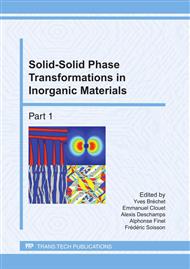p.49
p.55
p.61
p.67
p.73
p.79
p.84
p.90
p.99
Martensitic Transformations Using a Two-Body Isotropic Potential: Strain-Stress Simulations and Superelasticity in Monocrystals
Abstract:
We use an isotropic interaction potential for a set of classical identical particles to model martensitic transformations and the processes that are usually associated with them. We performed 2D numerical simulations of a strain-stress experiment and show that superelastic effect is present in our model.
Info:
Periodical:
Pages:
73-78
Citation:
Online since:
June 2011
Authors:
Price:
Сopyright:
© 2011 Trans Tech Publications Ltd. All Rights Reserved
Share:
Citation:


